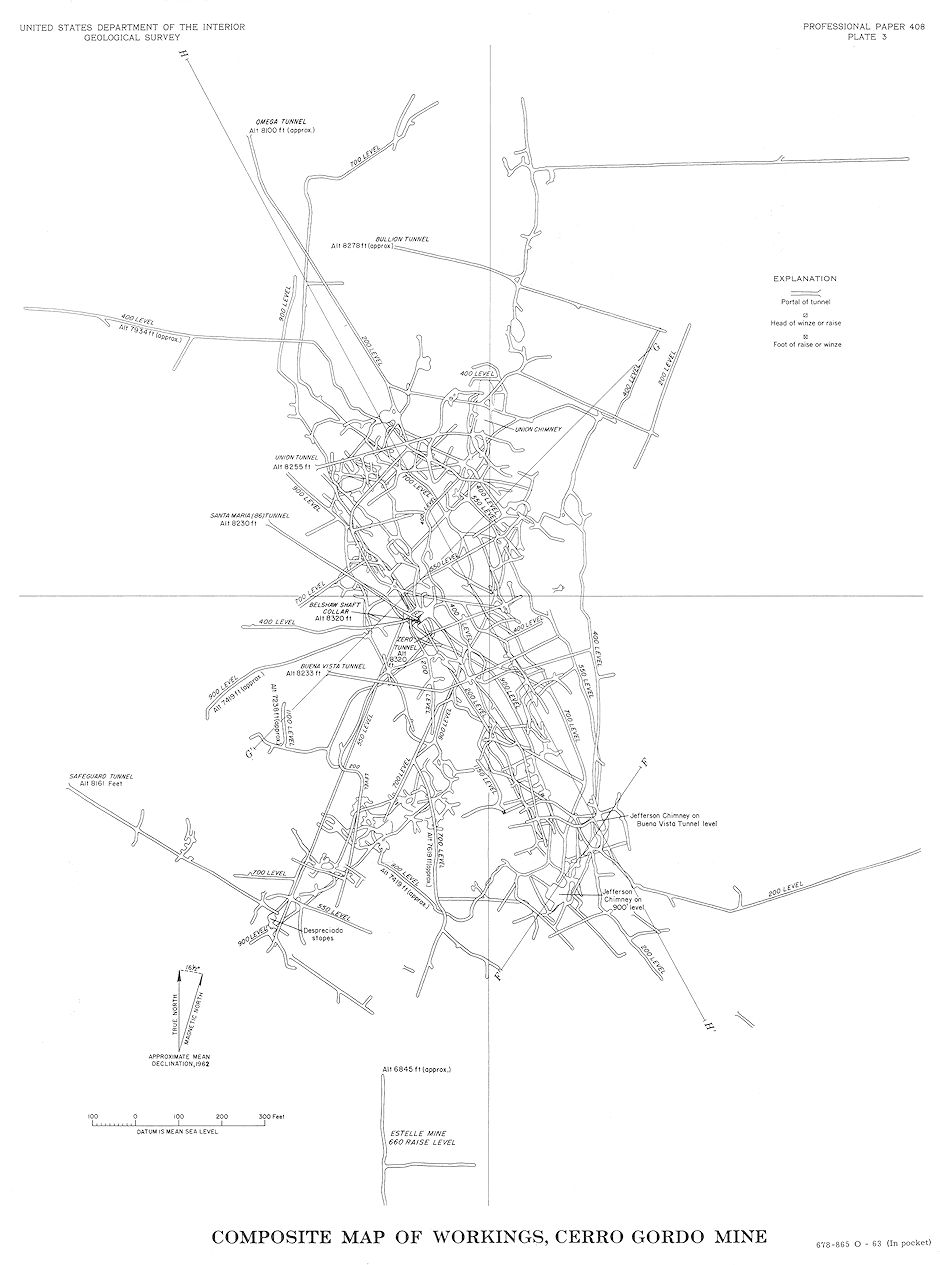While there were a number of mines and prospects within the Cerro Gordo District, almost 90% of the production came from independent mines and workings localized in an area of less than 1 square mile below Cerro Gordo Peak and which later became collectively known as the Cerro Gordo Mines. These included the Union Mine, Santa Maria Mine, and San Filipe Mine. During its peak years, the Cerro Gordo silver-lead bullion contained about 140 ounces of silver per ton. Average value of the bullion was $300/ton at $0.06/pound for lead and $1.29/ounce silver. Net profit after all costs of refining and transport often exceeded $150/ton.
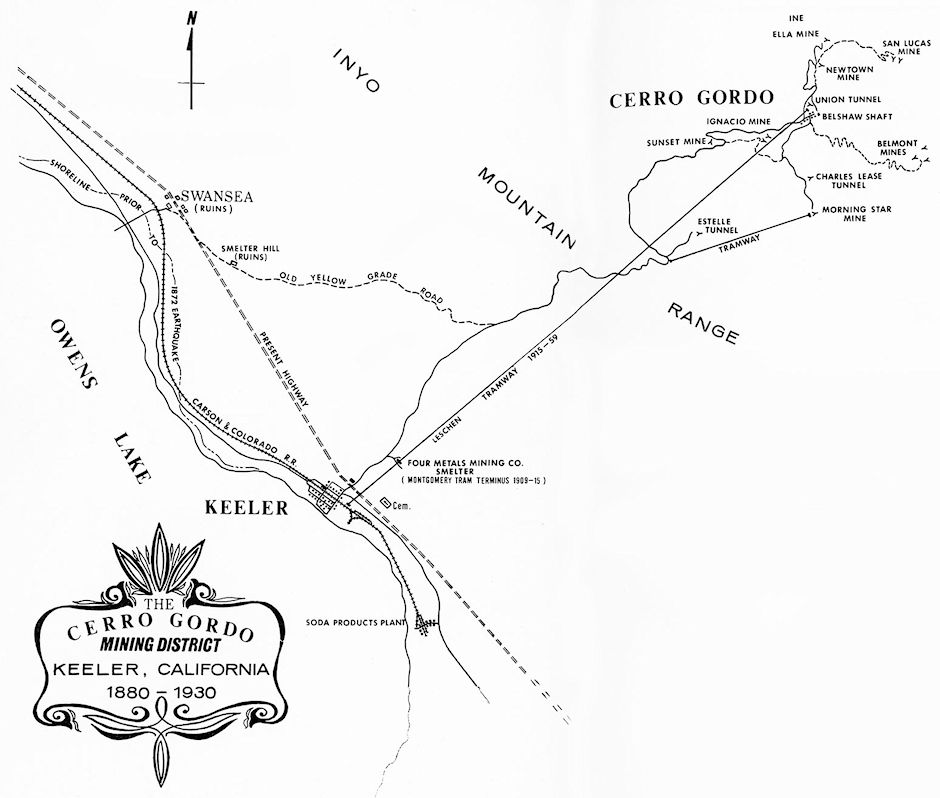
In 1870, the Union Mine was the most prolific of the Cerro Gordo Mines and was developed by a vertical shaft on the Union Chimney and by the Union Tunnel which struck the ore body 175 feet vertically below the discovery pit.
For the first few years the teams of huge freight wagons delivered so much silver bullion from Cerro Gordo that the Los Angeles News, in February, 1872 stated,"To this city, Cerro Gordo trade is invaluable. What Los Angeles now is, is mainly due to it. It is the silver cord that binds our present existence. Should it be unfortunately severed, we would inevitably collapse."
The property ultimately turned it into the largest producer of silver and lead in California, yielding ores that assayed at least as high as $300 per ton.
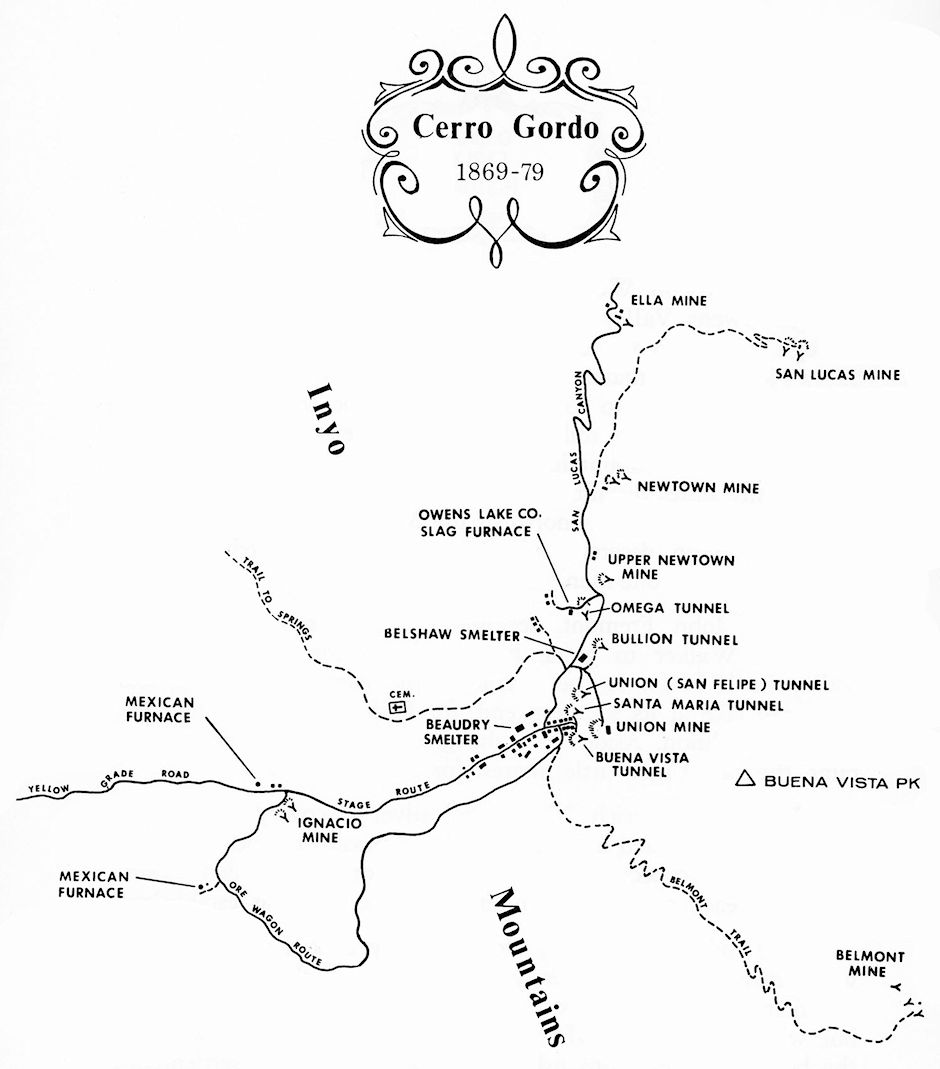
Cerro Gordo's peak production occurred in 1874 with its smelters producing eighteen tons a day of lead-silver bullion. During this time, the output of a single smelter at Cerro Gordo amounted to 300 silver lead "base-bullion" bars each weighing 87 pounds and valued at $335 each. The freight wagons could not keep up with output and the bullion bars stacked up like cordwood and were frequently used to build temporary buildings and shelters.
Between 1865 and 1877, various tunnels were driven eastward on the west flank of the peak to work specific shallow ore bodies. The more significant of these were the Buena Vista and the Santa Maria tunnels.
The Buena Vista Tunnel (at the 68' level) was driven eastward almost 350 feet to intersect the Buena Vista Fault. The tunnel continued 400-500 feet south along the fault and east to work the Jefferson Chimney on the south end of the mine area (this tunnel was opened up and extended as the 86 level in the later Belshaw Shaft).
The Santa Maria Tunnel (at the 90' level) extended 400 feet southeast to access the Santa Maria quartz vein.
North of the Union Chimney, the Bullion Tunnel (at the 42' level) was driven 300 feet east to exploit the Bullion Vein surface exposure and approximately 600 feet of north and south drifts were driven along the vein.
The Omega Tunnel (at the 200' level) was driven about 700 feet southeast to the ore bodies along the Omega Fault.
Similarly, the Zero Tunnel (at the 0' level) extended 200 feet east to intersect the Zero Vein which was drifted northward for approximately 100 feet.
Over the years, numerous exploratory drifts have been driven from these tunnels adding several miles to their original courses.
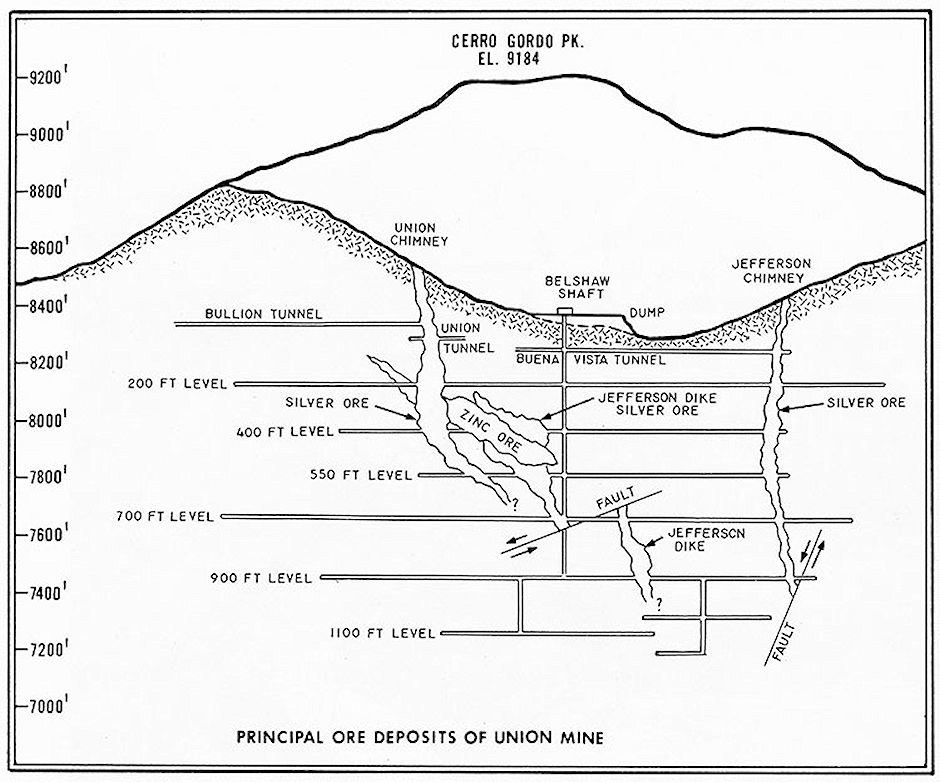
Major mining activity slowed after 1876, when Belshaw shut down his furnace. A fire destroyed the Union Mine hoist works in August 1877; they were repaired, but now the mine was in debt. Wages were cut to $3 a day and half of the miners left.
In 1877 a new vertical shaft, the Belshaw Shaft was sunk about 1,800 feet west of Cerro Gordo Peak to a 900-foot depth in an effort to locate deeper ores and stop the decline in ore coming from the mine. The main reason for the shaft was to locate the continuation of the Union Chimney which was lost at the 550 level, presumably by faulting.
The shaft was sunk vertically to 900 feet with levels at 86, 200, 400, 550, 700, and 900 feet but the Belshaw shaft failed to find the continuation of the Union Chimney or any other significant high-grade ore bodies. Extensive workings were extended to the north, east, and south from these levels. Upon completion of the shaft, ore could be hoisted to the Union Tunnel level, then trammed to the Belshaw furnace located 450 feet from the tunnel portal.
The Union closed in October 1879 and a month later, Beaudry's furnace was shut. Nadeau hauled out the last 208 ingots and a 420-pound glob of silver on November 21, 1879. Even the Bessie Brady ship was lost to fire in June 1882. and the Belshaw-Judson Furnaces were shut down the following year. The Beaudry smelter continued to operate until late 1879. Cerro Gordo was nearly deserted when the last load of bullion was shipped in 1879.
In 1905, the Great Western Ore Purchasing and Reduction Company acquired the Union Mine and envisioned building a 100-ton smelter for custom work and also to process ore left on the Cerro Gordo dumps, earlier considered too low grade for the technological methods then in use. By modern methods the ore could be worked profitably.
Cerro Gordo wasn't finished.
They produced a little ore into 1907 at which time the mine was taken over by the Four Metals Mining Company. With the intent of both reopening the mine and working the old smelter slags, the company built a 200-ton smelter near Keeler and built an aerial tramway connect the two. The company instead went bankrupt.
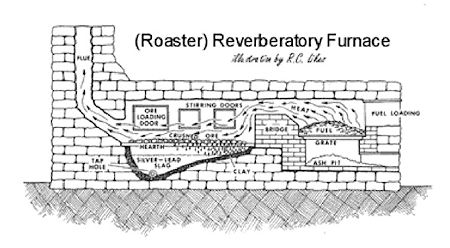
Reverberatory Furnace
Then, in 1907, high-grade zinc ore was discovered at the 900- to 1,000-foot level in the Union Mine. A 200-ton reverberatory smelter was constructed at the base of the mountain east of Keeler and a cable tramway was strung above the Yellow Grade Road to carry the ore down in buckets.
Results were mixed until 1911 when Louis D. Gordon and Associates leased the properties. In 1914 he took title to the property from the previous owner, the Four Metals Co., and incorporated the Cerro Gordo Mines Co.
In 1911, 160 feet north of the Belshaw Shaft on the 900 level, a winze was sunk to the 1,100 level with drifts on the 1,000 and 1,100 levels. A 250-foot winze was also driven 450 feet south of the main shaft with a drift from the bottom and one at about 1,030 feet. The total underground workings at Cerro Gordo are estimated at approximately 15 miles of tunnels and drifts.
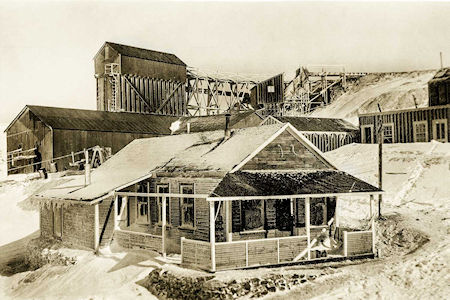
Snow blankets Cerro Gordo's Leschen Tram terminal and other buildings in this photograph from the L.D. Gordon Collection taken approximately 1915
L. D. Gordon and Associates were the first to recognize the value of the zinc carbonate ores. In 1914, they acquired title from the previous owner, the Four Metals Co., and reorganized the properties as the Cerro Gordo Mines Co. The Cerro Gordo Mines became a major source of high-grade zinc carbonate ore between 1911 and 1919.
Tortuous stopes were opened just east of and adjoining the old Union Chimney (China Stope) to exploit the zinc ore. The largest zinc stopes extended upward roughly on bedding incline from the 550 level to the south end of the Bullion Tunnel workings.
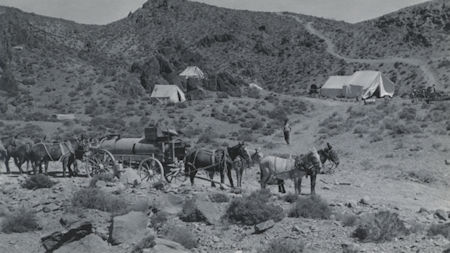
Mule driven wagons carrying water to a construction site for the Leschen tram (Friends of Cerro Gordo Collection)
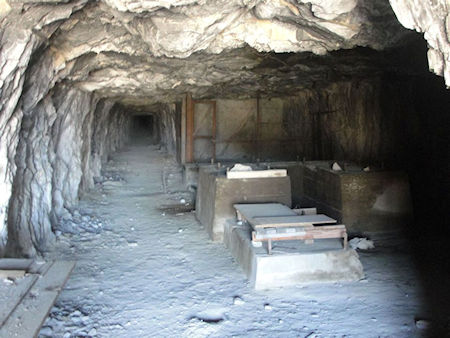
Inside Estelle mine
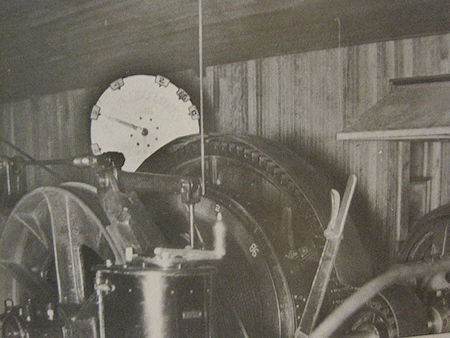
New Union Mine Hoist about 1915 (L. D. Gordon Collection)
Starting around 1915, slag (waste material) from the old dumps was reprocessed. Old tunnels were extended and new tunnels were driven; one, the Estelle, about two miles below camp, started in 1908 and by 1923 had reached the impressive length of 8,100 feet, running straight through half of the upper Inyo mountain range. In all, 37 miles of tunnels snake through the mountain.
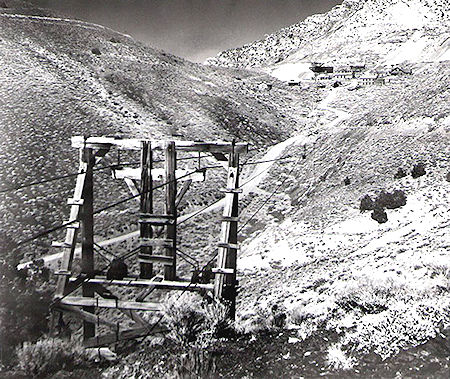
Leschen and Sons wire-rope aerial tramway
Electricity and telephones arrived in 1916. Explorations continued for new silver and lead deposits. With electric power for hoisting, compressors, and to operate a newly constructed 5.6-mile, gravity-powered Leschen and Sons wire-rope aerial tramway which replaced the initial Montgomery tram and moved 20 tons of zinc ore daily to the railroad at Keeler. From there it went to the United States Smelting and Refining Co. in Utah for processing.
From 1911 to 1919, the reopened Union gave up 8,022 tons of lead and 720,000 ounces of silver. During this period, new silver-lead ore bodies were also opened in the Jefferson Dike and Jefferson Chimney.
Cerro Gordo was booming again.
By 1920, about ten men were still employed by the Cerro Gordo mines company and silver-lead ore was being shipped. A few years later, in 1924, silver-lead ore on the old dumps was still being worked. Gross production of the Cerro Gordo camp from its early profitable years up until 1938 was about $17 million.
From 1923 - 1927, Cerro Gordo was operated under lease by a W. W. Waterson. In 1925, a significant new ore body was found by the Estelle Mines Company on the La Despreciada claim west of the old Cerro Gordo Mines. From 1928 - 1929, the Estelle Mining Company leased the Cerro Gordo properties, after which they were leased to the American Smelting and Refining Company which operated them until 1933.
No important discoveries have been made since the La Despreciada ore bodies. During this period the ore mined and shipped amounted to 10,000 tons with a gross value of $305,630. The approximate grade of ore shipped was .053 oz gold, 29 oz silver, 41% lead.
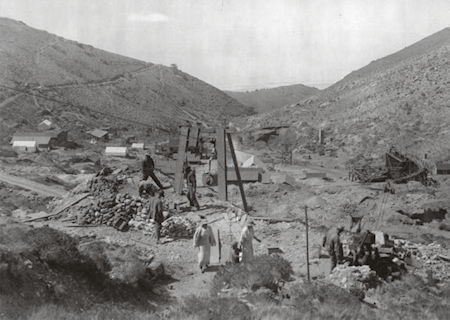
Picture shows Cornelia Gordon with her son and her nursemaid above town probably out looking for wildflowers (Friends of Cerro Gordo Collection)
Gordon eventually moved on, and American Smelting of Utah took over the mines. Total yields for 1929 were 3 million pounds of lead, 290,420 ounces of silver, 786 ounces of gold, and unknown amounts of zinc and tungsten. (Earlier miners apparently pocketed the gold, which didn't always make the official reports).
Since 1933, various lessees have driven short and unsuccessful headings from the 200, 400, and 550 levels. From May 1935 to Sept 1936, the property was leased by the "Silver-Lead Syndicate". During 1937 and 1938, the mine was again idle.
In 1940, the Cerro Gordo group was acquired by the Silver Spear Mining Corp. By this time the Cerro Gordo properties comprised 43 claims and about 550 acres. The property was operated from September 1943 - Sept 1944 by the Golden Queen Mine Company. Their work consisted of diamond drilling and drifting in an attempt to find a faulted segment of the Jefferson Ore body.
In 1944, Goldfields of South Africa reevaluated the property and the mine was temporarily reopened with little success. Diamond drilling was conducted at the south end of the mine from the 900 level in search of deep inferred fault segments of the Jefferson chimney but no mineable quantities of ore were found.
World War II brought the U.S. Army to Cerro Gordo to mine for zinc, a strategic material.
In 1946, the property was leased to W. C. Riggs and associates and purchased by them in 1949. In exploring in and around the China Stope area between the 200 and 550 levels, they did several thousand feet of diamond drilling and drove several thousand feet of drifts, raizes and winzes. Some diamond drilling was also done from the 500-foot level. A small amount of ore was developed and shipped. Cerro Gordo has been idle ever since.

Union Mine Hoist Building and Power Plant 2002
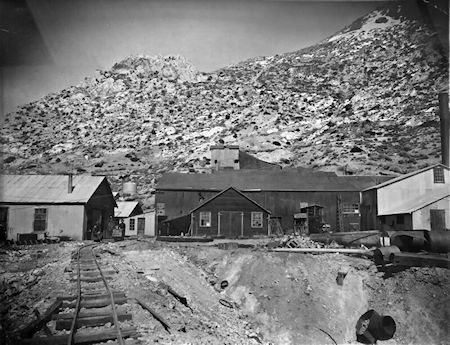
Historic picture of the Union Mine Hoist House
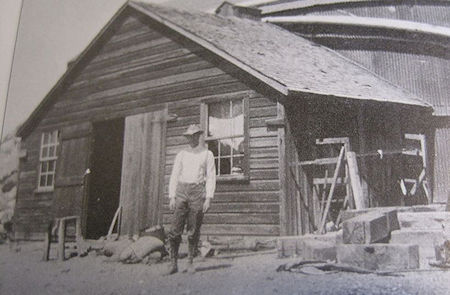
Blacksmith shop as shown at front center in above historical pictures at Union Mine Hoist House (Friends of Cerro Gordo Collection)
In 2005 a volunteer group calling themselves the Cerro Gordo Volunteer Fire Department did a major re-timbering of the Hoist House.
August 20, 2005 — Members of the newly organized Cerro Gordo Volunteer Fire Department mustered to repair and re-timber the Union Consolidated Mine hoist house. The present structure was built after the disastrous inferno that engulfed the hoist works and shaft down to 200 feet in August, 1877. It's wooden frame was constructed using mortise joints and wooden pegs.
A continuous onslaught by the relentless wind and winter snows peeled away much of the building's tin roof, exposing the Union shaft, hoisting equipment and compressor to the elements.
Members of the brigade spent two days toiling in Cerro Gordo's thin air to realign the aging timbers. The original wood fasteners were enhanced with the latest hardware consisting of metal bolts and brackets custom forged and welded to specifications.
Members of the Women's Auxiliary spent the afternoon working in the American Hotel kitchen preparing a feast for the boys and town guests that evening. Served in the Hotel's elegant main dining room, the feast consisted of roasted meat, fresh salads, potatoes, vegetables of the season and breads and deserts.
The following morning, work commenced at 5 a.m., accompanied by the expected complaints from some of the brigade members.
Meanwhile, breakfast was being rustled up at the Hotel. Morning eats included cooked eggs, bacon, sausages, sourdough pancakes and gallons of coffee.
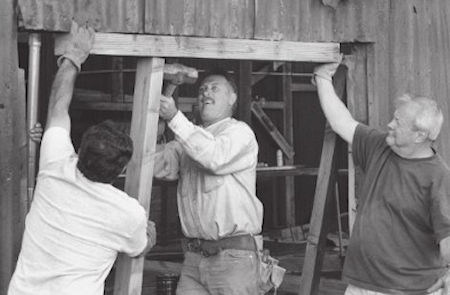
Mike Patterson (center) with volunteers calling themselves the Cerro Gordo Volunteer Fire Department doing re-timbering repairs in 2005 (Explore Historic California Collection)
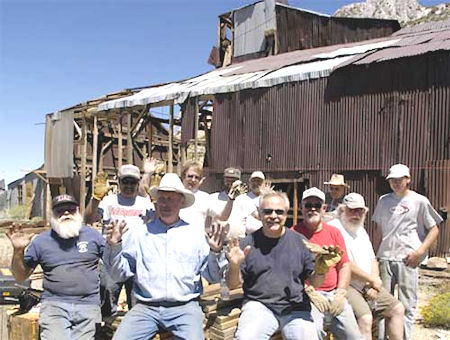
Members of the Cerro Gordo Volunteer Fire Department at day's end. The partially re-timbered hoist house is in the background. (Explore Historic California Collection)
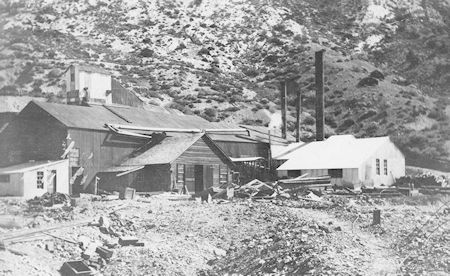
Historical picture of Union Mine Hoist House
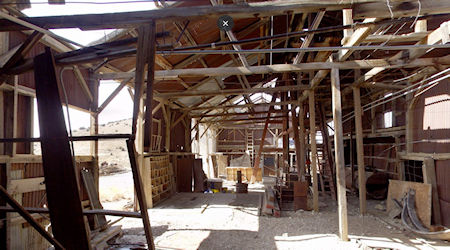
Inside Union Mine Hoist House 2002
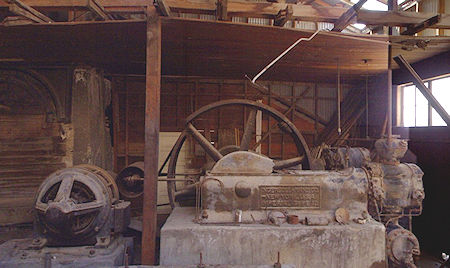
Compressor in the Union Mine Hoist House 2002
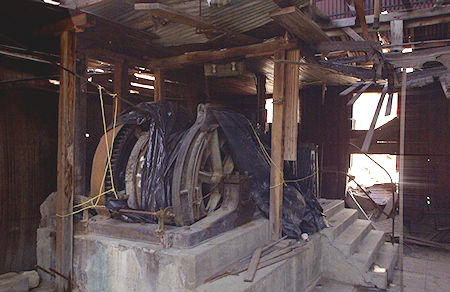
Union Mine Hoist Building Belshaw Shaft cage hoisting machinery 2002
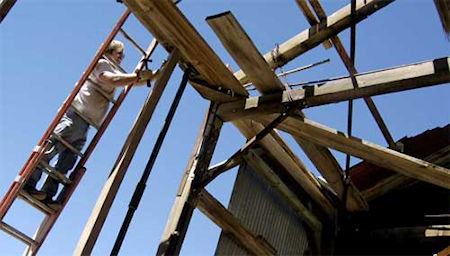
Re-timbering the Union Mine Hoist Building by group calling themselves the Cerro Gordo Volunteer Fire Department 2005 (Explore Historic California Collection)
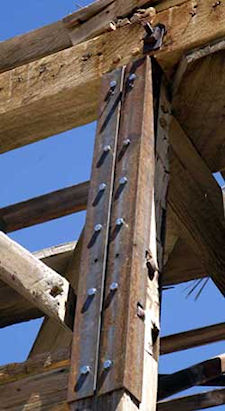
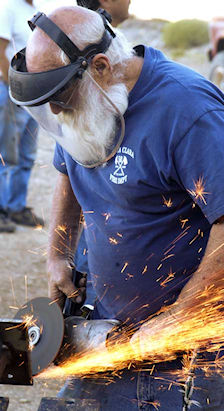
On left, Angle iron brackets bolt together a supporting beam. Original wooden pegs can be seen at the top of the bracket; on right, a volunteer custom modifies a bracket. (Explore Historic California Collection)
In 2013 the Union Mine Hoist House was significantly refurbished by a group from the Metabolic Studio.
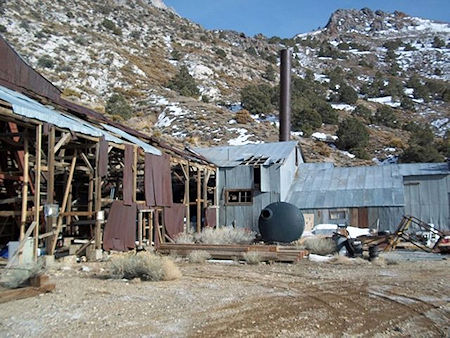
Union Mine Hoist House before restoration
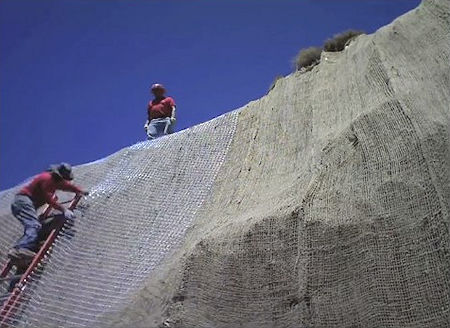
Metabolic Studio stabalizing the bank behind the Union Mine Hoist House 2013
The Union Mine Hoist House - Metabolic Studio 2013.
From the Metabolic Studio website: "The silence hides the great mysteries of the Inyo Mountains. About a hundred years ago this mine stopped functioning. A railway was built to connect the East Coast and the West Coast, to draw silver from this very mine.
That silver became the stuff of our dreams. Shipped from the Port of Los Angeles to Rochester, New York, it was made into film and a promise was made that anybody could capture their memories by taking a photograph.
This heavy machinery still stands, but the mountain, moved by glacial time, was falling in on it. The Metabolic Studio's magician team, Valley Crest, moved a mountain off of this mine, and then the Optics Division came in. Watch.
After a hundred years of stillness, every single jar of grease in this valley was applied to these cords, these steel cables, and down, down, down went our camera.
Down went our rig. Down we went like the men did for fifty or sixty years, facing their fears, all for silver. Silver was the material that created the West as we know it. Silver and Water."
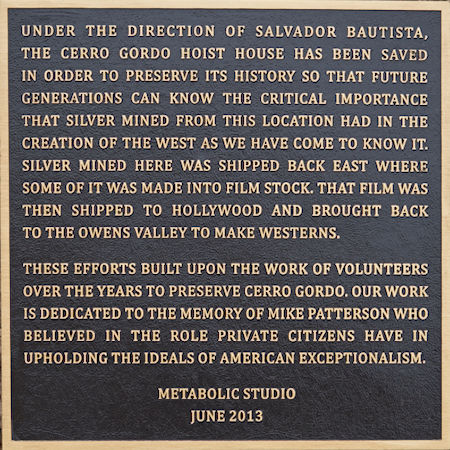
Plaque erected by Metabolic Studio in the Union Mine Hoist Building 2013
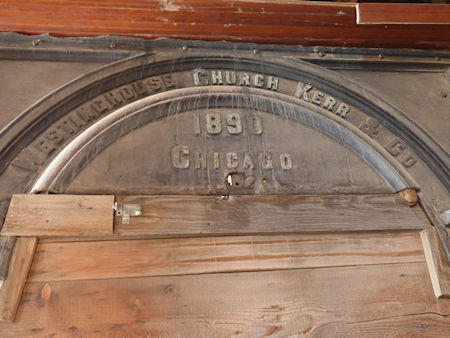
Name plate over furnace site in Union Mine Hoist House 2016. The boiler which provided steam for operations in early years was salvaged during World War II
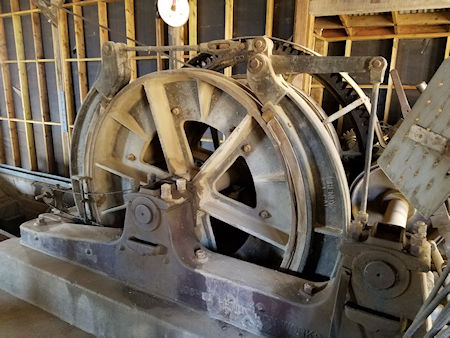
Belshaw shaft cage hoist machinery
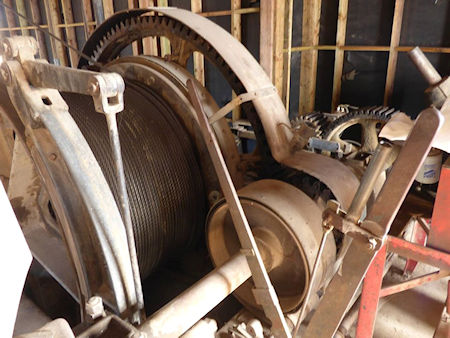
Belshaw shaft cage hoist machinery in Union Mine Hoist House 2016
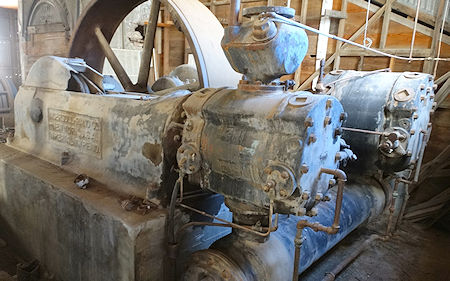
Compressor in Union Mine Hoist House
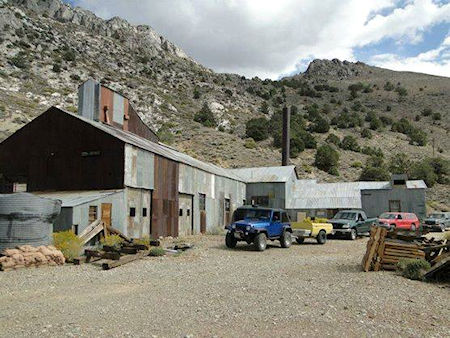
Union Mine Hoist House after restoration by Metabolic Studios 2013
(Friends of Cerro Gordo Collection)
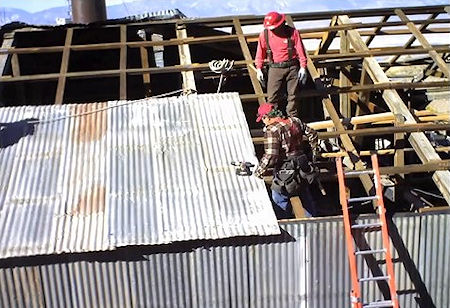
Metabolic Studio crew replacing the Union Mine Hoist House roof 2013
The cage and hoist machinery is operational as can be seen in the Metabolic Studios video at left, here below and at the end of the Mine Explorers video below. It was converted from electric drive to hydraulic drive about 1989 by Jody Stewart-Patterson.
Raising the cage in Union Mine Hoist House
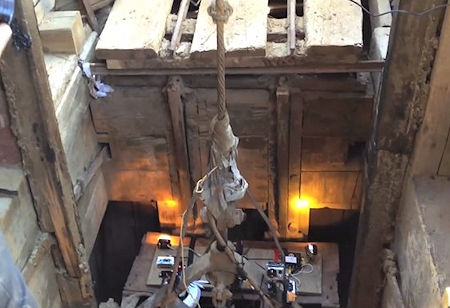
Cage descending in Union Mine Hoist House 2013
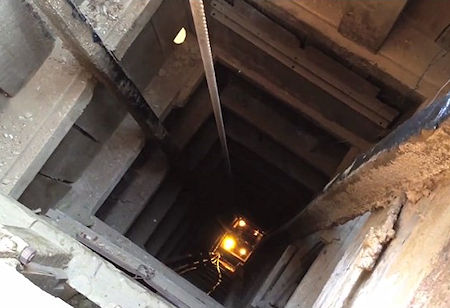
Looking down the Belshaw Shaft at the cage in Union Mine Hoist House 2013
Metabolic Studios Video of Belshaw Mine Shaft
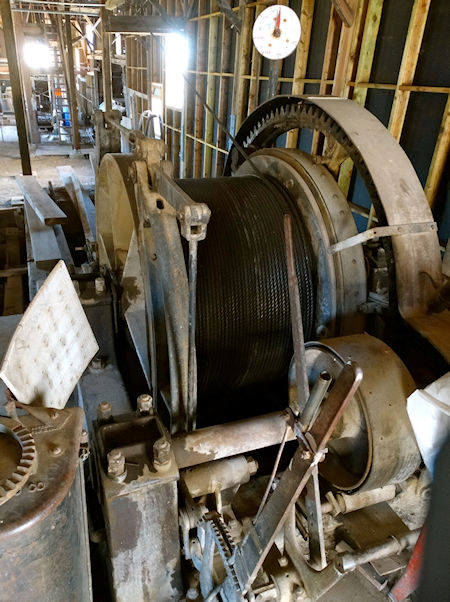
Hoist machinery for Belshaw shaft cage in Union Mine Hoist House
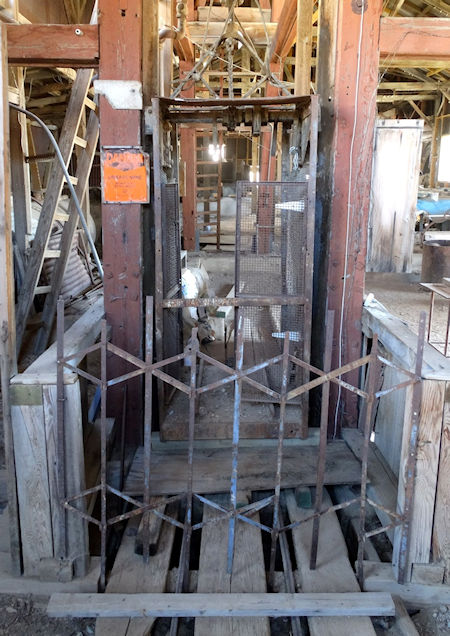
Belshaw shaft cage in Union Mine Hoist House
Exploration of Level 86, Beshaw Union Mine Shaft
In June 2018, four members of a group named Mine Explorers descended into the Belshaw Union Mine Shaft to examine the water system, which had stopped workking about 2010, and to explore the mine. Several video's from that exploration have been produced.
A short version concentrates on the examination of the water system and will be found here.
The video on the right, provided by Mine Explorers, was taken by a person not in this group who explored Level 86, aka Buena Vista Tunnel, of the Belshaw Union Mine Shaft.
The video below on the left, from the Mine Explorers expedition, concentrates on the mine tunnel exploration in much detail.
The video below on the right, from the Mine Explorers expedition, is a short version showing a portion of the tunnel exploration and the water system examination.
Full version of the tunnel exploration and water system examination by Mine Explorers June 2018. This has been edited. Original version here
Short version of the tunnel exploration and water system examination by Mine Explorers June 2018. This has been edited. Original version here
The chart below shows the areas of the mine that were explored in red. The level 86 tunnel is labeled Buena Vista Tunnel. The next level down, the 200 level, was not explored due to access from the Belshaw shaft being sealed off for unknown reasons.
There was access inside the 400 level down to the 550 level. Access to the Belshaw shaft from that portion of the 550 level was blocked by a collapse which explains the gap in the 550 level red line. The 550 level was accessable from the Belshaw shaft.
The 700 level, where the water pump is located, and the 900 level are accessable from the Belshaw shaft. All of the tunnel levels were blocked by collapses at various points which explains why the red lines do not extend the full length of the tunnels in most cases.
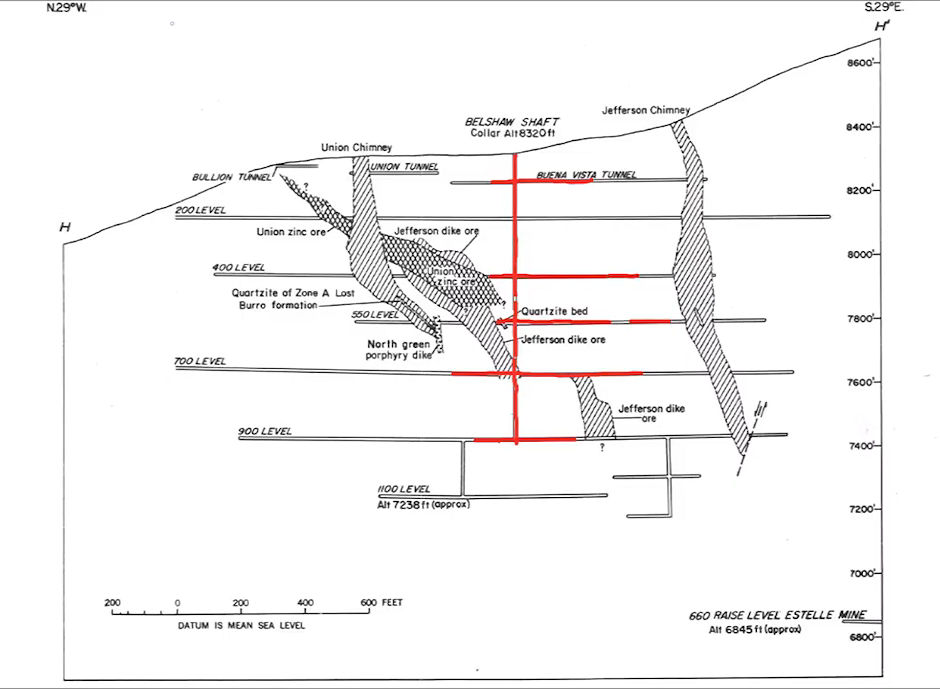
Chart of Union Mine Belshaw Shaft workings with areas explored marked in red
In October 2018 the Underground Explorers descended to the 900 foot level and then ascended to the 700 foot level to evaluate the water system whose pump had failed in about 2010. Following are pictures of their preparations and descent down the Belshaw shaft.

Historic picture of the Hoist House - Cerro Gordo
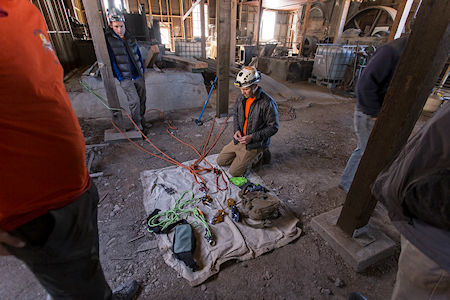
Rigging ropes (Underground Explorers Oct 2018)
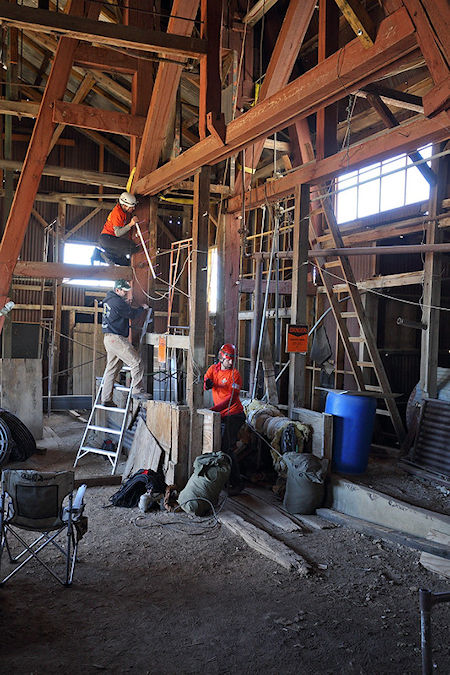
Rigging antenna and more ropes (Underground Explorers Oct 2018)
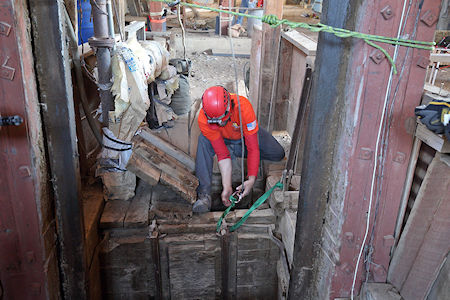
Final rigging at the collar (Underground Explorers Oct 2018)
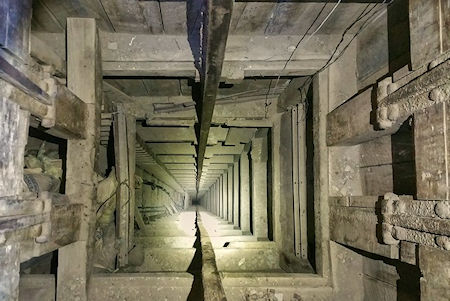
View down 900' Union mine shaft (Underground Explorers Oct 2018)
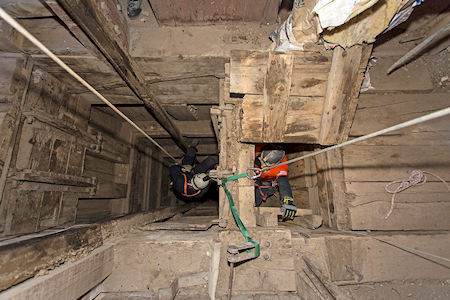
Dav and Fredrik head down in tandem (Underground Explorers Oct 2018)
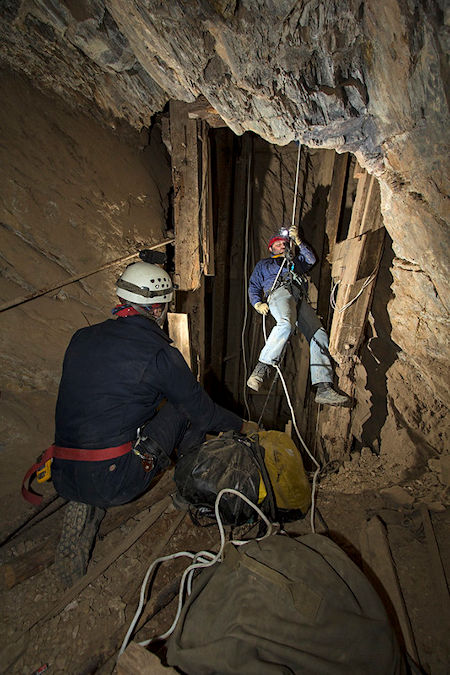
Kurt rappels to the 400' level (Underground Explorers Oct 2018)
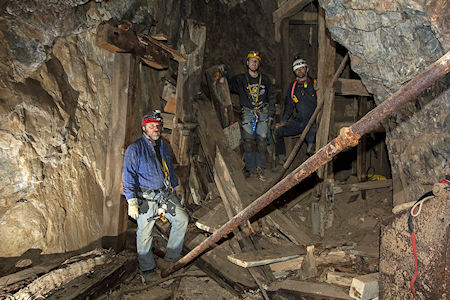
Group shot at the 900' shaft station (Underground Explorers Oct 2018)
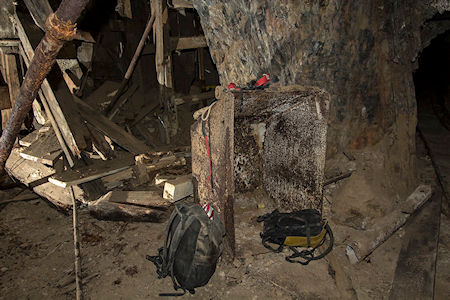
On the 900' level (Underground Explorers Oct 2018)
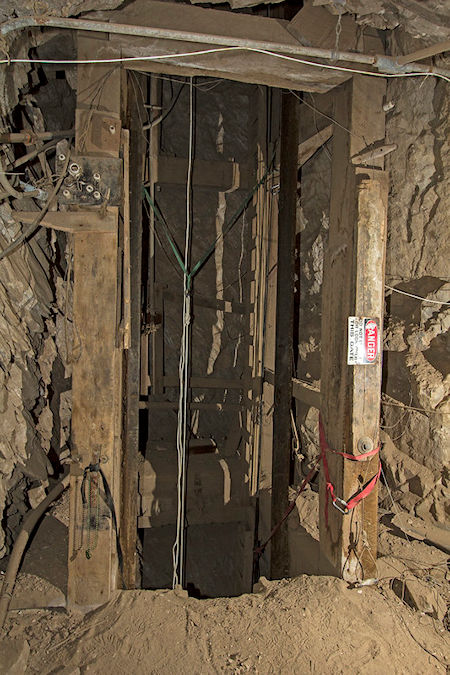
On the 700' level (Underground Explorers Oct 2018)
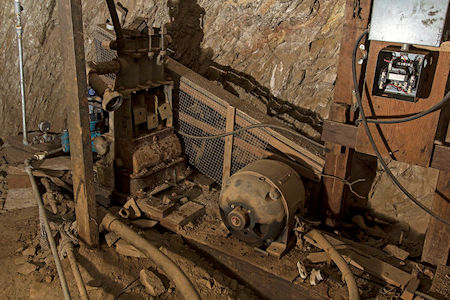
Old water pump at 700' level (Underground Explorers Oct 2018)
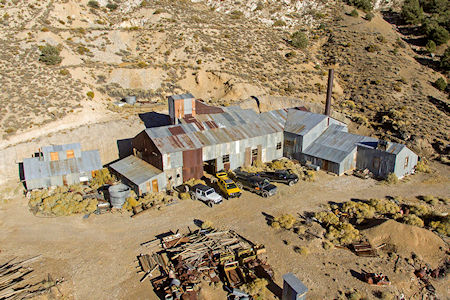
The Union Mine Hoist House (Underground Explorers Oct 2018)
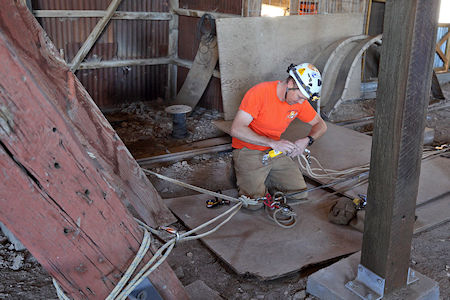
Setting up haul system (Underground Explorers Oct 2018)
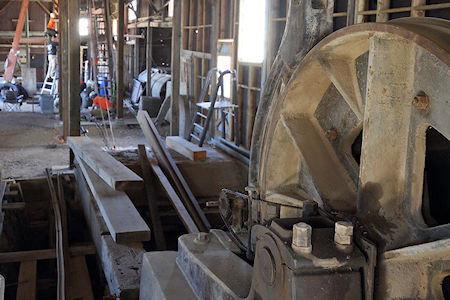
Activity around shaft (Underground Explorers Oct 2018)
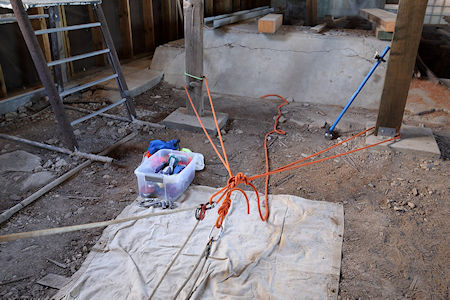
Ropes ready to go (Underground Explorers Oct 2018)
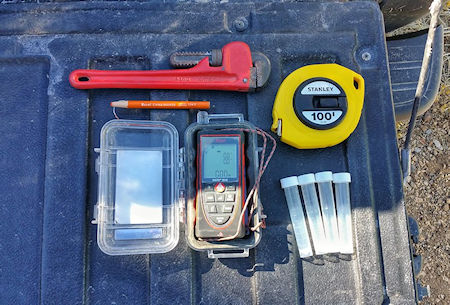
Tools for mapping and sampling (Underground Explorers Oct 2018)
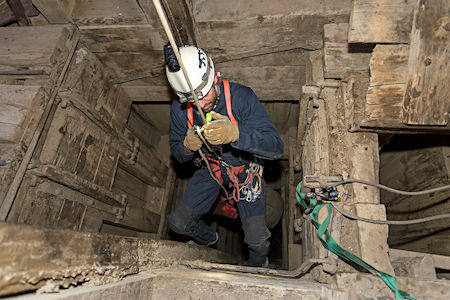
Dav starts his rappel (Underground Explorers Oct 2018)
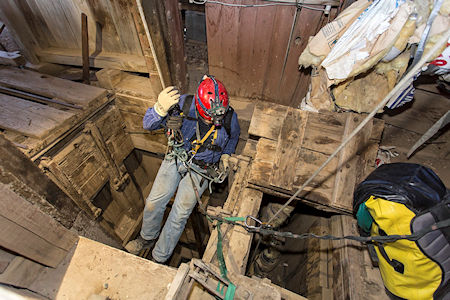
Kurt starts his rappel (Underground Explorers Oct 2018)
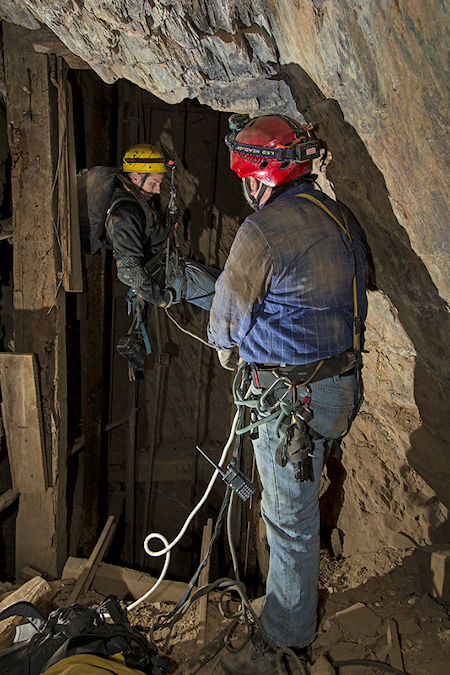
Stacy rappels to the 400' level (Underground Explorers Oct 2018)
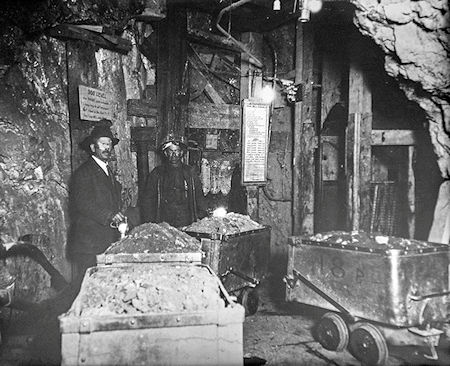
Historic 900' shaft station photo, L. D. Gordon in suit at left
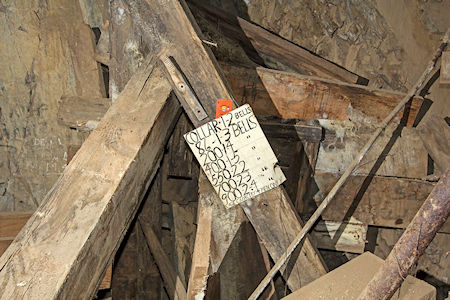
Decidedly less fancy signals sign (Underground Explorers Oct 2018)
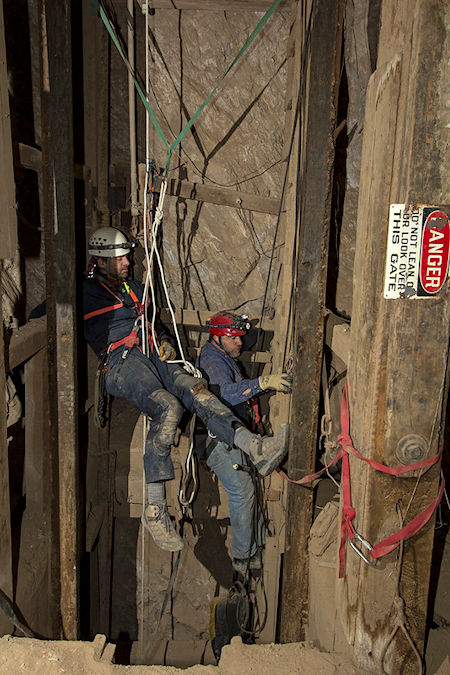
Dav and Kurt ascend to 700' level (Underground Explorers Oct 2018)
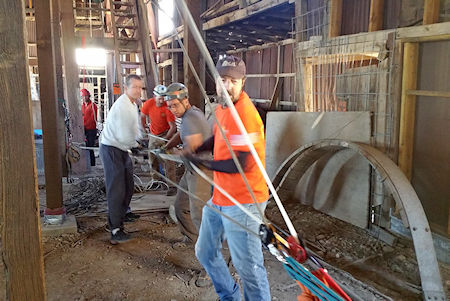
Pulling up 1000' of rope (Underground Explorers Oct 2018)











